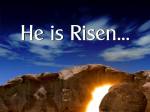 At the center of Christianity is found a miracle; not just any miracle, but the miracle of all miracles. This miracle is the resurrection of Jesus Christ. This doctrine is unique and sets Christianity apart from every other religion and worldview. If true, this one event changes the dynamic of every aspect of life. If true, this one event brings hope to a despairing world. But what is the resurrection? Why is it essential? Most importantly, are there reasons for believing that it is true? This article will seek to present some basic information on the resurrection of Jesus Christ
At the center of Christianity is found a miracle; not just any miracle, but the miracle of all miracles. This miracle is the resurrection of Jesus Christ. This doctrine is unique and sets Christianity apart from every other religion and worldview. If true, this one event changes the dynamic of every aspect of life. If true, this one event brings hope to a despairing world. But what is the resurrection? Why is it essential? Most importantly, are there reasons for believing that it is true? This article will seek to present some basic information on the resurrection of Jesus Christ
What is the doctrine?
The resurrection of Jesus Christ is to be understood as the return to life of Jesus after having been dead for 3 days. The resurrection is different than just a return to life as Jesus would remain alive. Here, it would be considered that the ascension would hold great importance. I am writing a paper for a theology class on the ascension which I will share on the website in a few weeks. The resurrection is important because, if true, it would mean that Jesus has defeated the power of death and that all persons would be able to enjoy eternal life with God past this mortal life. In other words, it would prove an “afterlife” and the promise that the body that is possessed by each individual would also be resurrected to eternal perfection in the end times. Some would try to claim that a “spiritual resurrection” is plausible. But, N.T. Wright demonstrates that, “…’resurrection’ always denotes one position within that spectrum. ‘Resurrection’ was not a term for ‘life after death’ in general. It always means reembodiment” (Wright 1998, 111).
Why should the doctrine be believed?
Perhaps one of the more important questions that should be asked pertains to the truthfulness of the resurrection. Are there good reasons for believing that the resurrection is true? This article will present five reasons why the resurrection could…and in fact should…be accepted as a historical fact. (For more information on the evidence for the resurrection of Jesus Christ, see the series “Evidence for the Resurrection” in the March 2013 archives on this site.)
Early attestation and chain of authority
One of the earliest gospels written was the Gospel of Mark (circa 55AD). Mark records, “But when they looked up, they saw the stone, which was very large, had been rolled away. As they entered the tomb, they saw a young man dressed in a white robe sitting on the right side, and they were alarmed. ‘Don’t be alarmed,’ he said. ‘You are looking for Jesus the Nazarene, who was crucified. He has risen! He is not here. See the place where they laid him. But go, tell his disciples and Peter, ‘He is going ahead of you into Galilee. There you will see him, just as he told you (Mark 16:4-7).'” One of the earliest records was a formulation passed on to Paul which dates no later than 35AD. The formulation is recorded in 1 Corinthians 15:3ff which states, “For what I received I passed on to you as of first importance: that Christ died for our sins according to the Scriptures, that he was buried, that he was raised on the third day according to the Scriptures, and that he appeared to Cephas, and then to the Twelve. After that, he appeared to more than five hundred of the brothers and sisters at the same time, most of whom are still living, though some have fallen asleep. Then he appeared to James, then to all of the apostles, and last of all he appeared to me also, as to one abnormally born (1 Corinthians 15:3-8).”
Not only is there New Testament evidence confirming the resurrection of Jesus, there are also early extra-biblical attestations of the resurrection. Clement of Rome wrote in the late first-century, “There will be a future resurrection” (Clement, “The First Epistle of Clement,” 24). Ignatius of Antioch wrote in AD 105, “And I know that He was possessed of a body not only in His being born and crucified, but I also know He was so after His resurrection, and believe that He is so now” (Ignatius, “Epistle of Ignatius to the Smyrnaeans,” 3). The great apologist, Justin Martyr, wrote concerning Jesus, “If the resurrection were only spiritual, it was requisite that He, in raising the dead, should show the body lying apart by itself, and the soul living apart by itself. But now He did not do so, but raised the body, confirming in it the promise of life” (Justin Martyr, “On the Resurrection, Fragments,” 9). Irenaeus wrote in the late second-century, “Christ Jesus, the Son of God, who became incarnate for our salvation; and in the Holy Spirit, who proclaimed through the prophets the dispensations of God, and the advents, and the birth from a virgin, and the passion, and the resurrection from the dead, and the ascension into heaven in the flesh of the beloved Christ Jesus, our Lord” (Irenaeus, “Against Heresies,” 1.10.1).[1]
J. Warner Wallace showed that the chain of information extended from the earliest church to the full documents of the New Testament contained in the Codex Sinaiticus, dating to the early 300s AD. In charts in his book Cold-case Christianity,[2] Wallace shows that Jesus taught Peter (30/33), Peter taught Mark (who wrote the gospel that bears his name) (50), Mark taught Anianus (75), Avilius (95), Kedron (100), Primus (115) and Justus (130), who taught Pantaenus (195), who taught Clement (210), who taught Origen (250), who taught Pamphilus (300), who taught Eusebius (335) which takes us to the Codex Sinaiticus and the Council of Laodicea (350-363). The lineage of Paul can be seen as the following: Paul saw the risen Christ, who taught Linus (70) and Clement of Rome (95), Clement taught Evaristus (100), Alexander (110), Sixtus (120), Telesphorus (130), Hyginus (135), and Pius (150), Pius passed the information to Justin Martyr (160), who taught Tatian (175). The lineage of John is as follows: the apostle John was an eyewitness and was taught by Jesus (30/33), John taught Ignatius (110) and Polycarp (110), Ignatius and Polycarp taught Irenaeus (185), who taught Hippolytus (220). Wallace writes, “Unfortunately Hippolytus was persecuted under Emperor Maximus Thrax and exiled to Sardinia, where he most likely died in the mines. The writings of Hippolytus (like the writings of Irenaeus before him) confirm that the New Testament accounts were already well established in the earliest years of the Christian movement” (Wallace 2013, 221). So what this shows is that the resurrection was not a late legendary development, but rather an accepted fact amongst the earliest Christians. This also shows that the resurrection was not an addition far after the fact, but was a tradition passed on from the eyewitnesses of the risen Jesus.
Skeptics became believers
Richard Dawkins is a hardcore skeptic. Would it not be a strong case if one like Richard Dawkins claimed to have had an encounter with God and became a believer? Before one scoffs at such a notion, it should be noted that many adversaries of the Christian faith in our day and time are having visions of Christ and are coming to faith.
Now what if I were to tell you that there were two skeptics of Jesus who eventually came to faith in Jesus? What if I were to also tell you that such an occurrence transpired after the resurrection of Jesus? There are two such cases. First, there is James. James was the brother of Jesus. He was skeptical of Jesus’ ministry. John writes, “For even his own brothers did not believe in him” (John 7:5). Yet James is listed among those who saw the risen Jesus in 1 Corinthians 15 and later became the first pastor of the church in Jerusalem.
Second, there was Paul. Paul was a persecutor of the Christian faith. Paul even held the coats of those who stoned the Christian Stephen. What happened? Paul had an encounter with the resurrected Jesus. Paul became a believer and one of the strongest advocates of the faith.
Psychological reasons
It is possible for individuals to die for something they believe in and be wrong. However, it is much more difficult for individuals to die for something they know to be true or false. All except one disciple (John) died gruesome deaths. Not a one of them denied the resurrection of Christ as a historical event. If there was some form of conspiracy, all one would have done is told the scheme to the authorities and Christianity would have been over. Tell the authorities where the body was located. It could be exposed. Christianity would be dead. However, not only did this not occur, the message of the gospel first spread in the land where Jesus had been crucified and buried. That is even more difficult to explain unless it is true.
Numerous resuscitations
For one who claims that dead people simply do not come back to life, then what do you do with the numerous cases of near-death experiences (NDEs) where individuals, some who are badly injured and/or diseased, come back to life? Just a few days ago from the writing of this article, Fox 8 out of Cleveland, Ohio reported the story of Brian Miller. Miller had suffered from a heart condition which left him dead for 45-minutes. Miller experienced a NDE and came back with no brain damage (check out http://fox8.com/2014/02/17/man-shares-near-death-experience-i-started-walking-toward-the-light/ for more information). Granted, there is a difference between resuscitation and a resurrection. Nonetheless, the naturalist is in trouble if one uses a Humean attack in claiming that dead people do not come back to life. Apparently, they do.
Why is the doctrine essential?
The resurrection is central to the faith. The New Testament writers state the importance of believing in the resurrection of Christ. Jesus Himself said, “I am the resurrection and the life. The one who believes in me will live, even though they die; and whoever lives by believing in me will never die. Do you believe this” (John 11:25)? Paul writes, “If you declare with your mouth, ‘Jesus is Lord,’ and believe in your heart that God raised him from the dead, you will be saved” (Romans 10:9). Therefore, the resurrection is essential to the Christian faith. Even more, the resurrection gives a person hope in that this life is not the end of our existence. With the resurrection, death has died and life lives on in glorious bliss for eternity. What could be better than that?
Bibliography
All Scripture, unless otherwise noted, comes from The New International Version. Grand Rapids: Zondervan.
Clement. The First Epistle of Clement.
House, H. Wayne, and Joseph M. Holden. Charts of Apologetics and Christian Evidences. Grand Rapids: Zondervan, 2006.
Ignatius. Epistle of Ignatius to the Smyrnaeans.
Irenaeus. Against Heresies, 1.10.1
Justin Martyr. On the Resurrection, Fragments.
Stratford, Suzanne. “Heaven and Back? Man Says He ‘Started Walking Toward the Light.'” Fox8.com. (February 17, 2014). http://fox8.com/2014/02/17/man-shares-near-death-experience-i-started-walking-toward-the-light/. Accessed February 24, 2014.
Wallace, J. Warner. Cold-case Christianity. Colorado Springs: David C. Cook, 2013.
Wright, N.T. “Christian Origins and the Resurrection of Jesus: The Resurrection as a Historical Problem.” Sewanee Theological Review, 41:2 (1998): 111.
[1] Quotes were compiled in H. Wayne House and Joseph M. Holden, Charts of Apologetics and Christian Evidences (Grand Rapids: Zondervan, 2006), Chart 56.
[2] Information in this paragraph comes from J. Warner Wallace, “Were They Accurate,” Cold-case Christianity (Colorado Springs: David C. Cook, 2013), 216-228.









